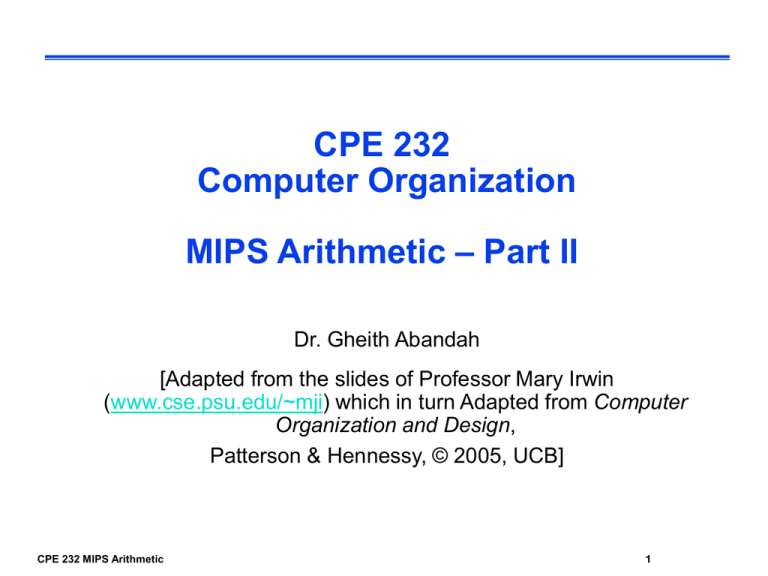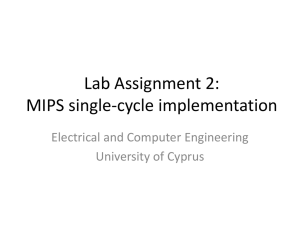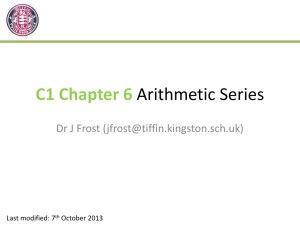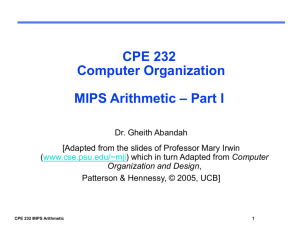MIPS Arithmetic
advertisement

CPE 232 Computer Organization MIPS Arithmetic – Part II Dr. Gheith Abandah [Adapted from the slides of Professor Mary Irwin (www.cse.psu.edu/~mji) which in turn Adapted from Computer Organization and Design, Patterson & Hennessy, © 2005, UCB] CPE 232 MIPS Arithmetic 1 Shift Operations Also need operations to pack and unpack 8-bit characters into 32-bit words Shifts move all the bits in a word left or right sll $t2, $s0, 8 #$t2 = $s0 << 8 bits srl $t2, $s0, 8 #$t2 = $s0 >> 8 bits op rs rt rd shamt funct Notice that a 5-bit shamt field is enough to shift a 32bit value 25 – 1 or 31 bit positions Such shifts are logical because they fill with zeros CPE 232 MIPS Arithmetic 2 Shift Operations, con’t An arithmetic shift (sra) maintain the arithmetic correctness of the shifted value (i.e., a number shifted right one bit should be ½ of its original value; a number shifted left should be 2 times its original value) so sra uses the most significant bit (sign bit) as the bit shifted in note that there is no need for a sla when using two’s complement number representation sra $t2, $s0, 8 #$t2 = $s0 >> 8 bits The shift operation is implemented by hardware separate from the ALU using a barrel shifter (which would take lots of gates in discrete logic, but is pretty easy to implement in VLSI) CPE 232 MIPS Arithmetic 3 Multiply Binary multiplication is just a bunch of right shifts and adds n multiplicand multiplier partial product array n can be formed in parallel and added in parallel for faster multiplication double precision product 2n CPE 232 MIPS Arithmetic 4 Multiplication Hardware CPE 232 MIPS Arithmetic 5 Optimized Multiplication Hardware CPE 232 MIPS Arithmetic 6 Fast Multiplication Units CPE 232 MIPS Arithmetic 7 Fast Multiplication Units CPE 232 MIPS Arithmetic 8 MIPS Multiply Instruction Multiply produces a double precision product mult $s0, $s1 op rs rt # hi||lo = $s0 * $s1 rd shamt funct Low-order word of the product is left in processor register lo and the high-order word is left in register hi Instructions mfhi rd and mflo rd are provided to move the product to (user accessible) registers in the register file Multiplies are done by fast, dedicated hardware and are much more complex (and slower) than adders Hardware dividers are even more complex and even slower; ditto for hardware square root CPE 232 MIPS Arithmetic 9 Division Division is just a bunch of quotient digit guesses and left shifts and subtracts n quotient n 0 0 0 dividend divisor 0 partial remainder array 0 0 remainder n CPE 232 MIPS Arithmetic 10 Division Hardware CPE 232 MIPS Arithmetic 11 MIPS Divide Instruction Divide generates the reminder in hi and the quotient in lo div $s0, $s1 # lo = $s0 / $s1 # hi = $s0 mod $s1 op rs rt rd shamt funct Instructions mfhi rd and mflo rd are provided to move the quotient and reminder to (user accessible) registers in the register file As with multiply, divide ignores overflow so software must determine if the quotient is too large. Software must also check the divisor to avoid division by 0. CPE 232 MIPS Arithmetic 12 Representing Big (and Small) Numbers What if we want to encode the approx. age of the earth? 4,600,000,000 or 4.6 x 109 or the weight in kg of one a.m.u. (atomic mass unit) 0.0000000000000000000000000166 or 1.6 x 10-27 There is no way we can encode either of the above in a 32-bit integer. Floating point representation (-1)sign x F x 2E Still have to fit everything in 32 bits (single precision) s E (exponent) 1 bit 8 bits F (fraction) 23 bits The base (2, not 10) is hardwired in the design of the FPALU More bits in the fraction (F) or the exponent (E) is a trade-off between precision (accuracy of the number) and range (size of the number) CPE 232 MIPS Arithmetic 13 IEEE 754 FP Standard Encoding Most (all?) computers these days conform to the IEEE 754 floating point standard (-1)sign x (1+F) x 2E-bias Formats for both single and double precision F is stored in normalized form where the msb in the fraction is 1 (so there is no need to store it!) – called the hidden bit To simplify sorting FP numbers, E comes before F in the word and E is represented in excess (biased) notation Single Precision Double Precision E (8) F (23) E (11) F (52) 0 0 0 0 0 nonzero 0 nonzero ± 1-254 anything ± 1-2046 anything ± 255 0 ± 2047 0 255 nonzero 2047 nonzero CPE 232 MIPS Arithmetic Object Represented true zero (0) ± denormalized number ± floating point number ± infinity not a number (NaN) 14 Floating Point Addition Addition (and subtraction) (F1 2E1) + (F2 2E2) = F3 2E3 Step 1: Restore the hidden bit in F1 and in F2 Step 1: Align fractions by right shifting F2 by E1 - E2 positions (assuming E1 E2) keeping track of (three of) the bits shifted out in a round bit, a guard bit, and a sticky bit Step 2: Add the resulting F2 to F1 to form F3 Step 3: Normalize F3 (so it is in the form 1.XXXXX …) - If F1 and F2 have the same sign F3 [1,4) 1 bit right shift F3 and increment E3 - If F1 and F2 have different signs F3 may require many left shifts each time decrementing E3 Step 4: Round F3 and possibly normalize F3 again Step 5: Rehide the most significant bit of F3 before storing the result CPE 232 MIPS Arithmetic 15 Floating-Point Adder CPE 232 MIPS Arithmetic 16 MIPS Floating Point Instructions MIPS has a separate Floating Point Register File ($f0, $f1, …, $f31) (whose registers are used in pairs for double precision values) with special instructions to load to and store from them lwcl $f1,54($s2) #$f1 = Memory[$s2+54] swcl $f1,58($s4) #Memory[$s4+58] = $f1 And supports IEEE 754 single add.s $f2,$f4,$f6 #$f2 = $f4 + $f6 and double precision operations add.d $f2,$f4,$f6 #$f2||$f3 = $f4||$f5 + $f6||$f7 similarly for sub.s, sub.d, mul.s, mul.d, div.s, div.d CPE 232 MIPS Arithmetic 17 MIPS Floating Point Instructions, Con’t And floating point single precision comparison operations c.x.s $f2,$f4 #if($f2 x $f4) cond=1; else cond=0 where x may be eq, neq, lt, le, gt, ge and branch operations bclt 25 #if(cond==1) go to PC+4+100 bclf 25 #if(cond==0) go to PC+4+100 And double precision comparison operations c.x.d $f2,$f4 #$f2||$f3 x $f4||$f5 cond=1; else cond=0 CPE 232 MIPS Arithmetic 18









